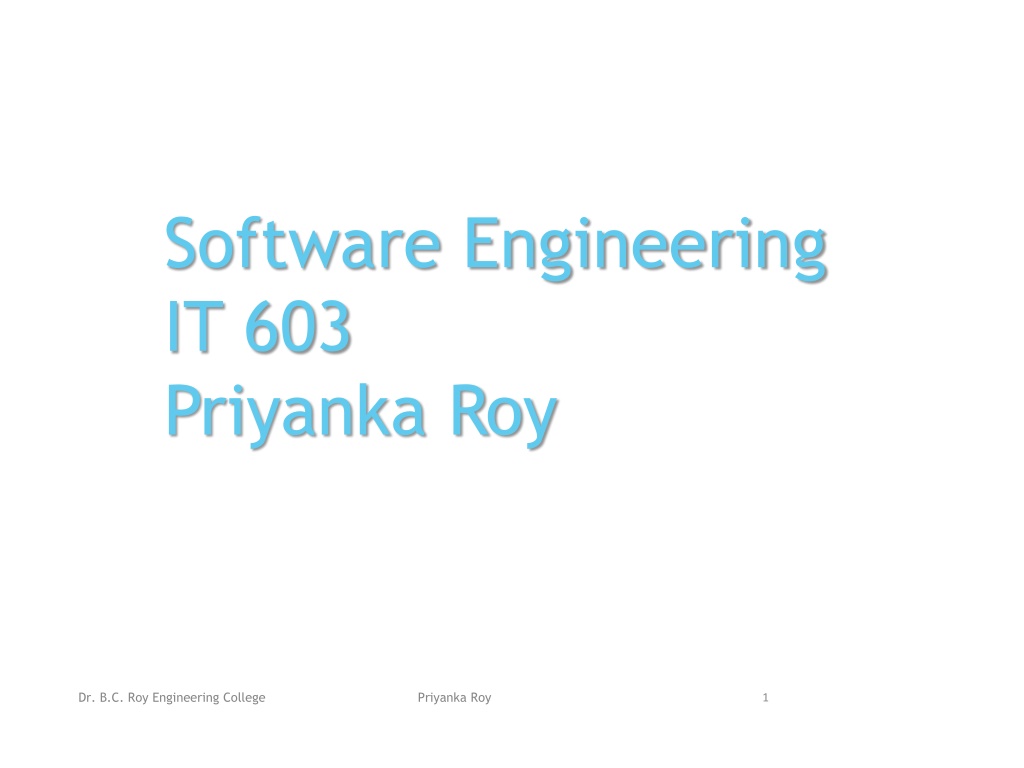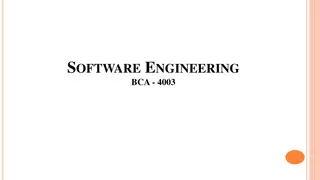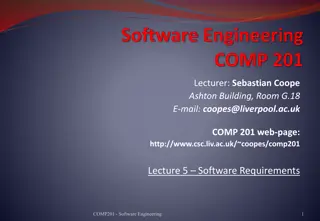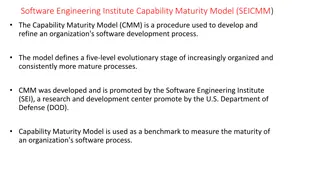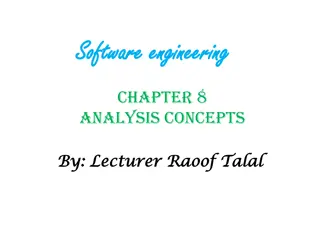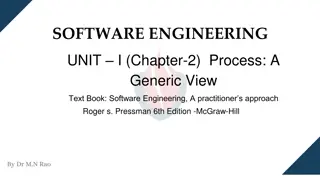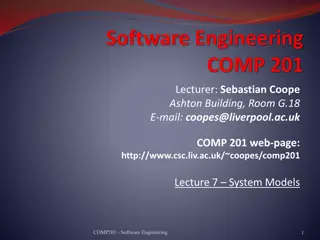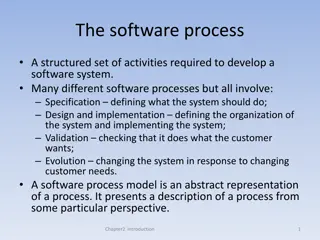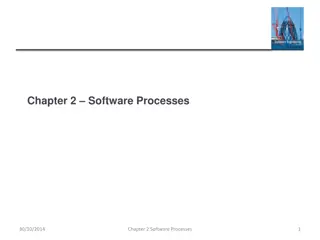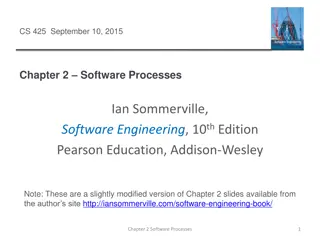Understanding Software Engineering Principles and Process Models
Software engineering involves managing complexity to create efficient software using sound engineering principles. It encompasses the systematic development, operation, and maintenance of software. Various process models guide software development stages, focusing on reliability, portability, efficiency, human engineering, testability, understandability, and modifiability.
- Software Engineering
- Development Process
- Complexity Management
- Engineering Principles
- Process Models
Download Presentation

Please find below an Image/Link to download the presentation.
The content on the website is provided AS IS for your information and personal use only. It may not be sold, licensed, or shared on other websites without obtaining consent from the author. Download presentation by click this link. If you encounter any issues during the download, it is possible that the publisher has removed the file from their server.
E N D
Presentation Transcript
Software Engineering IT 603 Priyanka Roy Dr. B.C. Roy Engineering College Priyanka Roy 1
Syllabus of MAKAUT Software Engineering IT603 Contracts: 3L Credits- 3 Module I Software Engineering Objectives, Definitions ,Soft ware Process models - Waterfall Model , Prototype model, RAD, Evolutionary Models ,Incremental, Spiral(4L) Software Project Planning- Feasibility Analysis, Technical Feasibility, Cost- Benefit Analysis, COCOMO model. [4L] Module II Structured Analysis , Context diagram and DFD, Physical and Logical DFDs ,Data Modelling, ER diagrams, Software Requirements Specification (5L) Module III Design Aspects :Top-Down And Bottom-Up design; Decision tree, decision table and structured English, Structure chart, Transform analysis Functional vs. Object- Oriented approach. [3L] Dr. B.C. Roy Engineering College Priyanka Roy 2
Syllabus of MAKAUT Software Engineering IT603 Contracts: 3L Credits- 3 Module IV Unified Modelling Language Class diagram, interaction diagram: collaboration diagram, sequence diagram, state chart diagram, activity diagram, implementation diagram. (4L) Module V Coding & Documentation Structured Programming, Modular Programming, Module Relationship- Coupling, Cohesion, OO Programming, Information Hiding, Reuse, System Documentation. [5L] Testing Levels of Testing, Integration Testing, System Testing.(5L) Software Quality, Quality Assurance, Software Maintenance, Software Configuration Management, Software Architecture. [6L] Reference Books: 1. 2. 3. 4. Software Engineering : A practitioner s approach Pressman(TMH) Software Engineering- Pankaj Jalote (Wiley-India) Software Engineering- Rajib Mall (PHI) Software Engineering Agarwal and Agarwal (PHI) Dr. B.C. Roy Engineering College Priyanka Roy 3
What is Software Engineering Software engineering is about managing all the sources of complexity to produce effective software. The seminal definition: [Software engineering is] the establishment and use of sound engineering principles in order to obtain economically software that is reliable and works efficiently on real machines. The IEEE definition: Software Engineering: (1) The application of a systematic, disciplined, quantifiable approach to the development, operation, and maintenance of software; that is, the application of engineering to software. (2) The study of approaches as in (1). Dr. B.C. Roy Engineering College Priyanka Roy 4
Software Process Models Reliability Portability Efficiency Human Engineering Testability Understandability Modifiability Dr. B.C. Roy Engineering College Priyanka Roy 5
Software Process model A software life cycle model (also called process model) is a descriptive and diagrammatic representation of the software life cycle. A life cycle model represents all the activities required to make a software product transit through its life cycle phases. It also captures the order in which these activities are to be undertaken. In other words, a life cycle model maps the different activities performed on a software product from its inception to retirement. Different life cycle models may map the basic development activities to phases in different ways. Thus, no matter which life cycle model is followed, the basic activities are included in all life cycle models though the activities may be carried out in different orders in different life cycle models. Dr. B.C. Roy Engineering College Priyanka Roy 6
SDLC A software life cycle model defines entry and exit criteria for every phase. A phase can start only if its phase-entry criteria have been satisfied. So without software life cycle model the entry and exit criteria for a phase cannot be recognized. Without software life cycle models (such as classical waterfall model, iterative waterfall model, prototyping model, evolutionary model, spiral model etc.) it becomes difficult for software project managers to monitor the progress of the project. Dr. B.C. Roy Engineering College Priyanka Roy 7
Activities in each phase of the life cycle Activities undertaken during design: - The goal of the design phase is to transform the requirements specified in the SRS document into a structure that is suitable for implementation in some programming language. In technical terms, during the design phase the software architecture is derived from the SRS document. Two distinctly different approaches are available: the traditional design approach and the object-oriented design approach. Dr. B.C. Roy Engineering College Priyanka Roy 8
Activities in each phase of the life cycle Activities undertaken during coding and unit testing:- The purpose of the coding and unit testing phase (sometimes called the implementation phase) of software development is to translate the software design into source code. Each component of the design is implemented as a program module. The end- product of this phase is a set of program modules that have been individually tested. During this phase, each module is unit tested to determine the correct working of all the individual modules. It involves testing each module in isolation as this is the most efficient way to debug the errors identified at this stage. Dr. B.C. Roy Engineering College Priyanka Roy 9
The Software Process Structured set of activities required to develop a software system Specification Design Validation Evolution Activities vary depending on the organization and the type of system being developed. Must be explicitly modeled if it is to be managed. Dr. B.C. Roy Engineering College Priyanka Roy 10
Software Process Models Feasibility Study Requirements Analysis and Specification Hardware Development Hardware Software Partitioning Software Development Integration and Testing Project Management Dr. B.C. Roy Engineering College Priyanka Roy 11
Software Process model Specification: Set out the requirements and constraints on the system. Design: Produce a model of the system. Manufacture: Build the system. Test: Check the system meets the required specifications. Install: Deliver the system to the customer and ensure it is operational. Maintain: Repair faults in the system as they are discovered. Dr. B.C. Roy Engineering College Priyanka Roy 12
Different software life cycle models Many life cycle models have been proposed so far. Each of them has some advantages as well as some disadvantages. A few important and commonly used life cycle models are as follows: Classical Waterfall Model Iterative Waterfall Model Prototyping Model Evolutionary Model Dr. B.C. Roy Engineering College Priyanka Roy Spiral Model 13
Waterfall Model The classical waterfall model is intuitively the most obvious way to develop software. Though the classical waterfall model is elegant and intuitively obvious, it is not a practical model in the sense that it can not be used in actual software development projects. Thus, this model can be considered to be a theoretical way of developing software. But all other life cycle models are essentially derived from the classical waterfall model. Dr. B.C. Roy Engineering College Priyanka Roy 14
Waterfall Model Classical waterfall model divides the life cycle into the following phases Feasibility Study Requirements Analysis and Specification Design Coding and Unit Testing Integration and System Testing Maintenance Dr. B.C. Roy Engineering College Priyanka Roy 15
Waterfall Model Shortcomings of the classical waterfall model The classical waterfall model is an idealistic one since it assumes that no development error is ever committed by the engineers during any of the life cycle phases . However, in practical development environments, the engineers do commit a large number of errors in almost every phase of the life cycle. Therefore, in any practical software development work, it is not possible to strictly follow the classical waterfall model . The Phase-entry and phase-exit criteria of each phase is required which is called iterative waterfall model. Dr. B.C. Roy Engineering College Priyanka Roy 16
Waterfall Process Model Feasibility Study Requirement Analysis & Specification Design Coding & Unit Testing Integration & System Testing 17 Maintenance Dr. B.C. Roy Engineering College Priyanka Roy
Waterfall Model Documents Activity Requirements analysis Requirements definition System specification Output documents Feasibility study, Outline requirements Requirements document Functional specification, Acceptance test plan Draft user manual Architectural specification, System test plan Interface specification, Integration test plan Design specification, Unit test plan Program code Unit test report Module test report Integration test report, Final user manual System test report Final system plus documentation Architectural design Interface design Detailed design Coding Unit testing Module testing Integration testing System testing Acceptance testing Dr. B.C. Roy Engineering College Priyanka Roy 18
Prototyping Model what is software prototyping ? It is the process of implementing the presumed software requirements with an intention to learn more about the actual requirements or alternative design that satisfies the actual set of requirements . Need for software prototyping -To assess the set of requirements that makes a product successful in the market -To test the feasibility without building the whole system. -To make end-user involved in the design phase Dr. B.C. Roy Engineering College Priyanka Roy 19
Prototyping Model A prototype is a toy implementation of the system. A prototype usually exhibits limited functional capabilities, low reliability, and inefficient performance compared to the actual software. A prototype is usually built using several shortcuts. The shortcuts might involve using inefficient, inaccurate, or dummy functions. The shortcut implementation of a function, for example, may produce the desired results by using a table look-up instead of performing the actual computations. A prototype usually Dr. B.C. Roy Engineering College Priyanka Roy 20 turns out to be a very crude version of the actual system.
Phases of prototyping Dr. B.C. Roy Engineering College Priyanka Roy 21
Types of Prototyping Dr. B.C. Roy Engineering College Priyanka Roy 22
Evolutionary Process Model Evolutionary software models are iterative. They are characterized in manner that enables the software engineers to develop increasingly more complete version of a software. This models are applied because as the requirements often change so the end product will be unrealistic, where a complete version is impossible due to tight market deadlines it is better to introduce a limited version to meet the pressure. Thus the software engineers can follow a process model that has been explicitly designed to accommodate a product that gradually complete over time. Dr. B.C. Roy Engineering College Priyanka Roy 23
Evolutionary Process Model Concurrent activities Initial version Specification Outline description Intermediate versions Development Final version Validation Dr. B.C. Roy Engineering College Priyanka Roy 24
Spiral model The Spiral model of software development is appears like a spiral with many loops. The exact number of loops in the spiral is not fixed. Each loop of the spiral represents a phase of the software process. For example, the innermost loop might be concerned with feasibility study. The next loop with requirements specification, the next one with design, and so on. Each phase in this model is split into four sectors (or quadrants) Dr. B.C. Roy Engineering College Priyanka Roy 25
Spiral model The following activities are carried out during each phase of a spiral model. -First quadrant (Objective Setting) During the first quadrant, it is needed to identify the objectives of the phase. Examine the risks associated with these objectives. - Second Quadrant (Risk Assessment and Reduction) A detailed analysis is carried out for each identified project risk. Steps are taken to reduce the risks. For example, if there is a risk that the requirements are inappropriate, a prototype system may be developed. -Third Quadrant (Development and Validation) Develop and validate the next level of the product after resolving the identified risks. - Fourth Quadrant (Review and Planning) - Review the results achieved so far with the customer and plan the next iteration around the spiral Dr. B.C. Roy Engineering College Priyanka Roy 26
Spiral Process Model Determine objectives alternatives and constraints Evaluate alternatives identify, resolve risks Risk analysis Risk analysis Risk analysis Opera- tional protoype Prototype 3 Prototype 2 Risk analysisProto- REVIEW type 1 Requirements plan Life-cycle plan Simulations, models, benchmarks Concept of Operation S/W Product design requirements Detailed design Requirement validation Development plan Code Unit test Design V&V Integration and test plan Integration test Plan next phase Acceptance test Develop, verify next-level product Service Dr. B.C. Roy Engineering College Priyanka Roy 27
Incremental model In incremental model the whole requirement is divided into various builds. Multiple development cycles take place here, making the life cycle. Cycles are divided up into smaller, more easily managed modules. Each module passes through the requirements, design, implementation and testing phases. A working version of software is produced during the first module, so you have working software early on during the software life cycle. Each subsequent release of the module adds function to the previous release. The process continues till the complete system is achieved. cycle a multi-waterfall Dr. B.C. Roy Engineering College Priyanka Roy 28
Incremental model Dr. B.C. Roy Engineering College Priyanka Roy 29
Incremental model Advantages of Incremental model: Generates working software quickly and early during the software life cycle. This model is more flexible less costly to change scope and requirements. It is easier to test and debug during a smaller iteration. In this model customer can respond to each built. Lowers initial delivery cost. Easier to manage risk because risky pieces are identified and handled during it d iteration. Dr. B.C. Roy Engineering College Priyanka Roy 30
Incremental model Disadvantages of Incremental model: Needs good planning and design. Needs a clear and complete definition of the whole system before it can be broken down and built incrementally. Total cost is higher than waterfall. Dr. B.C. Roy Engineering College Priyanka Roy 31
RAD model RAD model is Rapid Application Development model. It is a type of incremental model. In RAD model the components or functions are developed in parallel as if they were mini projects. The developments are time boxed, delivered and then assembled into a working prototype. This can quickly give the customer something to see and use and to provide feedback regarding the delivery and their requirements. Dr. B.C. Roy Engineering College Priyanka Roy 32
RAD model Dr. B.C. Roy Engineering College Priyanka Roy 33
RAD model The phases in the rapid application development (RAD) model are: Business modeling : The information flow is identified between various business functions. Data modeling : Information gathered from business modeling is used to define data objects that are needed for the business. Process modeling : Data objects defined in data modeling are converted to achieve the business information flow to achieve some specific business objective. Description are identified and created for CRUD of data objects. Application generation: Automated tools are used to convert process models into code and the actual system. Testing and turnover: Test new components and all the interfaces. Dr. B.C. Roy Engineering College Priyanka Roy 34
RAD model Advantages of the RAD model: Reduced development time. Increases reusability of components Quick initial reviews occur Encourages customer feedback Integration from very beginning solves a lot of integration issues. Disadvantages of RAD model: Depends on strong team and individual performances for identifying business requirements. Only system that can be modularized can be built using RAD Requires highly skilled developers/designers. High dependency on modeling skills Inapplicable to cheaper projects as cost of modeling and Dr. B.C. Roy Engineering College Priyanka Roy 35
Agile model Agile development model is also a type of Incremental model. Software is developed in incremental, rapid cycles. This results in small incremental releases with each release building on previous functionality. Each release is thoroughly tested to ensure software quality is maintained. It is used for time critical applications. Extreme Programming (XP) is currently one of the most well known agile development life cycle model. Dr. B.C. Roy Engineering College Priyanka Roy 36
Agile model Dr. B.C. Roy Engineering College Priyanka Roy 37
Agile model Advantages of Agile model: Customer satisfaction by rapid, continuous delivery of useful software. People and interactions are emphasized rather than process and tools. Customers, developers and testers constantly interact with each other. Working software is delivered frequently (weeks rather than months). Face-to-face conversation is the best form of communication. Close, daily cooperation between business people and developers. Continuous attention to technical excellence and good design. Regular adaptation to changing circumstances. Dr. B.C. Roy Engineering College Priyanka Roy 38
Agile model Disadvantages of Agile model: In case of some software deliverables, especially the large ones, it is difficult to assess the effort required at the beginning of the software development life cycle. There is lack of emphasis on necessary designing and documentation. The project can easily get taken off track if the customer representative is not clear what final outcome that they want. Only senior programmers are capable of taking the kind of decisions required during the development process. Hence it has no place for newbie programmers, unless combined with experienced resources. Dr. B.C. Roy Engineering College Priyanka Roy 39
Process Model Problems Waterfall High risk for new systems because of specification and design problems. Low risk for well-understood developments using familiar technology. Prototyping Low risk for new applications because specification and program stay in step. High risk because of lack of process visibility. Transformational High risk because of need for advanced technology and staff skills. Dr. B.C. Roy Engineering College Priyanka Roy 40
Hybrid Process Models Large systems are usually made up of several sub-systems. The same process model need not be used for all subsystems. Prototyping for high-risk specifications. Waterfall model for well-understood developments. Process Visibility Software systems are intangible so managers need documents to assess progress. Waterfall model is still the most widely used model. Dr. B.C. Roy Engineering College Priyanka Roy 41
